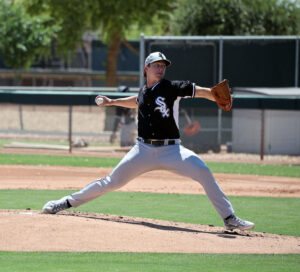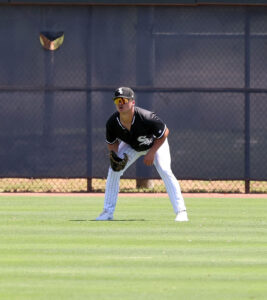Ins and outs of scouting from a professional’s perspective

As baseball fans, scouting players is in our DNA. It doesn’t matter if we have any actual experience or skill. There’s always the fun in trying to predict who will be the next Mike Trout or Joe Borchard.
Scouting is an integral part of being a fan. This article will explore how a professional scout goes about determining whether or not your favorite high school, college or minor league player has what it takes to make the big leagues.
FutureSox welcomed Brian Sakowski, National Scouting Supervisor for Perfect Game USA, for the inside track. In this phone interview, Brian gave us tips and tricks for evaluating players from the bleachers, the couch, or watching YouTube videos on your phone.
Before I had him get into the details, I asked Brian to show me his credentials. Perfect Game USA is a scouting service that runs events across the country and a few internationally. It holds tournaments and showcases for players 13U through college with the objective of getting them in front of pro scouts and college coaches for recruitment purposes. As the head of the MLB draft and JUCO, Brian has evaluated his share of players. So, push down the sunglasses, grab a radar gun and open up that clock app on your phone — we’re going to baseball scouting school.
SCOUTING PITCHING

“The first thing I start with is his physicality,” Sakowski shared. “Do I think he’s going to get bigger and stronger? Then it’s mechanics. How does the delivery work? What arm slot is he throwing from? Does the stuff he tries to throw work well out of that arm slot? Would it work better in a different way?
“I’m a big believer in the lower half (of the body) telling the story. You can tell a lot by the direction of his stride. Or the direction his hips take. You can tell a lot by which way his foot is pointing as he lands. Then I move my way up the body. How is the timing? Is the arm in a good spot when the front foot lands? That’s hugely important. If you see a pitcher missing up and to his arm side a lot. He’s got bad timing.”
Sakowski continued regarding pitcher evaluation.
“Then it goes to stuff,” he said. “What does my radar gun say? Is he getting swings and misses on the pitch? Does he attack with it? Where does he want to put it verses where it actually goes? You can tell a lot about command by gauging how close he is to hitting the catcher’s target. It’s that’s simple.”
STARTER OR RELIEVER?
In making this determination, Sakowski asks himself several essential questions.
- Is his delivery repeatable?
- Is he making a ton of effort on every pitch? If yes, he’s likely not a starter.
- Can he hold his stuff and throw strikes for seven innings and 112 pitches?
- Does he have the command to start?
- Does he have three pitches?
- Can he get lefties and righties out multiple times through the order?
Brian elaborated on how to determine if a pitcher’s delivery is repeatable.
You want the pitcher to make the exact same movements every time he throws a pitch. You don’t want him to vary the arm stroke. You don’t want to see the length or the slot vary. You want a pitcher to have the exact same mechanical profile for every pitch he throws regardless of pitch type.
From repeatability comes command. If a player is repeating that exact same move over and over again, he is building muscle memory. Then he can hone in on where he wants the baseball to go. If from pitch to pitch, his stride varies. Or his arm stroke varies. Maybe his slot drifts. Those are the things that lead to lapses in command.
Then you turn your attention to the quality of his stuff. There’s a theory that says to be a starter, a player needs to have three pitches, and one of those three has to be a change-up.
Brian Sakowski/Perfect Game USA
DEFENSE – ASSIGNING A POSITION

“The first thing you look at is athleticism,” Sakowski continued. “In 99% of the cases, a player has to have a requisite amount of athleticism to play a given spot. A shortstop needs to be more athletic than a first baseman. A center fielder needs to be more athletic than a left fielder.
“From there, it breaks down by position. On the infield, a guy can be super athletic, but if he’s got shit hands, he can’t play the infield. If he’s got bad feet, he can’t play the infield. Does he have a good arm? Good throwing mechanic? If he’s got speed, then maybe you move him to center. I don’t base anything on a flashy play. If someone can make it – great, but if he kicks three balls hit right at him, who cares? Or maybe he can’t make the flashy play but doesn’t kick balls hit at him and has enough range to make him a useable defender.”
First, it’s athleticism, then it’s instincts, then it’s speed and arm.
Brian Sakowski on assessing a player’s defensive skills
“In the outfield, it’s similar,” Sakowski said. “Arm strength will dictate where guys will profile. If someone can’t play center but has a cannon, he’ll play right. If he’s got a 40 arm, he’s going to left. It’s athleticism; it’s instincts. We’ve seen guys who are really fast, who are bad outfielders. You need a player to be fast to play a good center field, but If he doesn’t have the instincts, then speed is wasted. Instincts are a repetition watch. That’s watching the player see fly balls off the bat in games. Then it’s simple things. Can he catch a fly ball?”
CATCHING

“For me, it starts with athleticism, same thing as everywhere else,” stated Sakowski.
“If a guy doesn’t have that baseline of being laterally agile enough to at least block a ridiculous breaking ball or a spiked 100 MPH fastball at an average level, then I’m not sure he can catch,” he continued. “Then you can judge raw arm strength. If that is adequate, you need to look at the explosion by which he gets out of his crouch, the quickness of his release, and the accuracy of the arm.
“You can allow for average skill to play up a little bit. Or do they take that grade down because they’re clunky? Then it’s accuracy, you’re judging pop times. That’s an objective thing that you get with numbers that mean something. You have to shoot through the lens of: are there going to be robot umpires now? It becomes two different profiles. If there are robot umpires, framing doesn’t mean shit anymore. All the guys that can frame but do nothing else will not be big leaguers.”
If human umpires remain, then it’s a balancing act between framing and catching ability. You can give up a little bit of one if you are getting the other.
Bottom line: “Who’s the dude that’s really athletic, that can block all these ridiculous breaking balls that pitchers throw now. Then can he throw, and can he hit.”
HITTING

“It’s as simple as ‘let me see bat speed and let me see impact,'” began Sakowski. “You aren’t going to kill someone for having a part of a swing you don’t necessarily like. With hitters, you can’t tell anything until it’s game time. You can watch bat speed, but you don’t know a thing about a guy until you see him take an at-bat.
“If a player doesn’t dominate against a lower-tier competition, that’s a red flag. No one has ever lost their career on one game, but if I see a player swing through a 77 MPH fastball six times, what is going on? You start to ask questions. Scouting hitters is basically looking into a crystal ball. No one knows for sure. There are guys drafted in the first round every year who never make it out of A-Ball. Hitting is the more abstract scouting art.”
Well, there you have it. You’re ready to find the next Fernando Tatis Jr. Let me get you Rick Hahn’s number. Oh, he hung up on you, maybe you should’ve said Mookie Betts.
Jimmy Lambert photo credit: Sean Williams/FutureSox
Want to know right away when we publish a new article? Type your email address in the box on the right-side bar (or at the bottom on a mobile device) and click “create subscription.” Our list is completely spam free, and you can opt out at any time Also, consider supporting FutureSox on Patreon! You can get early access to special articles and Patreon-only posts, in addition to more benefits.
Shop our exclusive merchandise! Show your support with FutureSox apparel.







Terrific article. As a former pitching coach, I love this kind of knowledge communicated by your site. Thank You.
Thanks for reading. I had fun writing it and learned quite a bit in the process. Ken Sawilchik